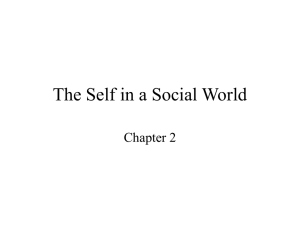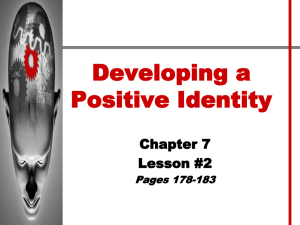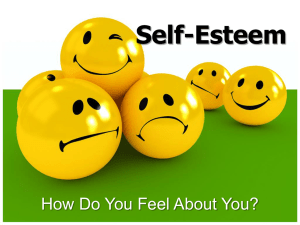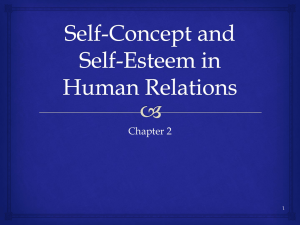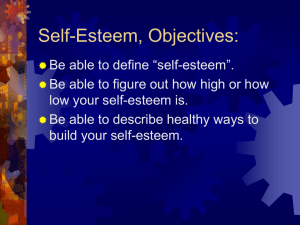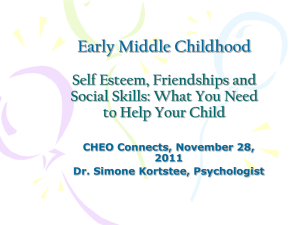The Self - Donna Vandergrift Psychology, Associate Professor
advertisement
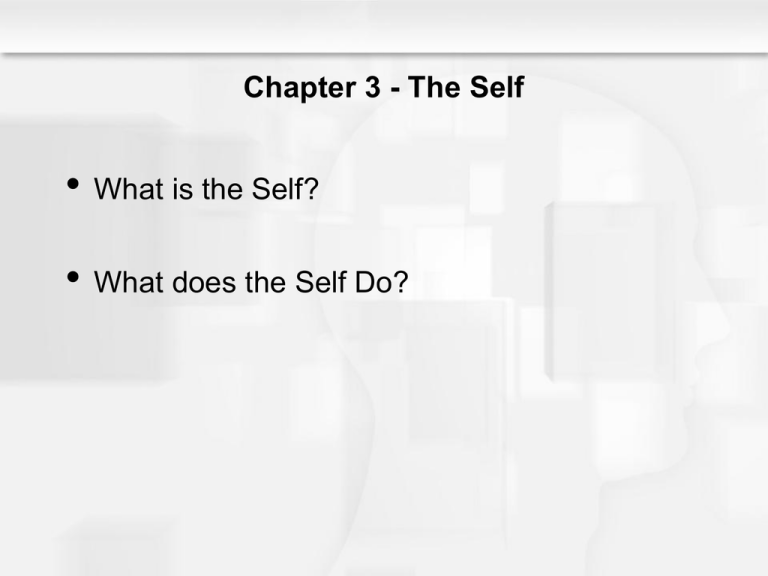
Chapter 3 - The Self • What is the Self? • What does the Self Do? • • • What is the Self? Three Main Parts Self Knowledge – Self Awareness – Self Schema Interpersonal Self – Public Self – “Persona” Agent Self – Executive Function – Active Self Where does the Self Come From? • Interaction between biology and the sociocultural environment – Is there a self without others? – How is your self as defined related to others? Functions of the Self • Organizational Function • – Self-Knowledge/Schemas – Who am I? – How should I present myself? Self-Regulation – Self-Control – How can I fit into Society? – What Roles should I fill? Cultural Differences of Selfhood • Independent self-construal (Individualistic) – What makes the self different • Interdependent self-construal (Collectivist) – What connects the self to the group Self-Awareness • Begins with Introspection – We don’t look inward much – When we do, we might not be aware of our true self • Self-Focused Attention – Private self-awareness – Public self-awareness • Usually involves evaluative comparison Purpose of Self-Awareness • Self-regulation • See how others view you • Manage behavior as you pursue goals Self Compared to Standards • Concepts of how things might possibly be – Ideals, norms, expectations, moral principles, laws, past experiences – Where do these standards come from? • Around age 2, begin use of standards – Beginning of self-awareness Self Awareness Theory Duvall & Wicklund, 1972 • • • • • Situation causes Self-Awareness We become Self-Aware We experience a Discrepancy Options: Change or Escape But current research says how we feel about our potential of reaching the standard may alter this reaction. Self-Awareness and Behavior • Self-awareness – Improves behavior • Act more socially appropriate • Adhere to personal standards • Escaping Self-Awareness – Why escape? – Methods Where Self Knowledge Comes From 1. Looking Outside • Looking-Glass Self (Cooley, 1902) – You imagine how you appear to others – You imagine how others will judge you – You develop an emotional response • Generalized Other (Mead, 1934) – A combination of others’ opinions Evaluating Looking-Glass Self • We do respond to feedback from others… but Self-Concept and other’s opinions of us are usually different. • We may not know how people regard us – People are reluctant to give us negative comments – We may not be receptive to negative comments 2. Looking Inside • Introspection – Privileged Access • Limitations of Introspection – Development – Children under 11 – Nisbett and Wilson attack on privileged access (1977) - Lack of metacognition – We may know what we think and feel, but not why – automatic processes at work 3. Looking At Others • Social Comparison – Upward social comparisons – Downward social comparisons 4. Look at our Behavior • Self-Perception Theory • Example (Bem, 1965) – Intrinsic motivation – Extrinsic motivation • Overjustification Effect (Deci, 1971) – Intrinsic motivation diminishes for activities associated with expected rewards Self-Esteem • Self-esteem – The value we place on ourselves. – A judgement that we make about our worth. – How much we like ourselves. What is Self-Esteem? • High Self-Esteem – Positive views • Low Self-Esteem – Absence of strong positive views What is Self-Esteem? • Self-Esteem Self-esteem – Self-serving bias • An innate tendency to want to see ourselves positively. • Tend to ignore negative feedback—”junk mail metaphor”. – Both high and low self-esteem individuals hold positive illusions: • Overestimate own skills and abilities. • Overestimate level of control over events • Unrealistic predictions of future success. Low Self-Esteem • Research on Low Self-Esteem – Do not want to fail – Self-concept confusion – Focus on self-protection – More prone to emotional highs and lows • Myth of Low-Self Esteem in United States Maintaining Self-Esteem Maintaining Self-Esteem • • • Self-evaluative Maintenance – We act to support our self-esteem. Social Comparisons – Compare our performance with others. – The standard then affects our self-esteem. Use Self-serving Bias – Interpret success and failure in the context of our selfesteem. • High self-esteem: Credit self for success and blame failure on outside circumstances. • Low self-esteem: Credit outside circumstances for success and blame failure on self. Distorted Perceptions of Nondepressed • Positive Illusions – Overestimate good qualities – Underestimate faults – Overestimate control over events – Unrealistically optimistic Negative Aspects of High Self-Esteem • Narcissism – Subset of high self-esteem – Tend to be more aggressive and violent • Higher Prejudice – Tend to think their group is better Pursuit of Self-Esteem • May have harmful consequences – Can compromise pursuit of competence – Impairs autonomy – Pressure to meet expectations of others – Weakens individual intrinsic motivation – Impairs learning – Can damage relationships – Can be harmful to health Self = Product of Social Interaction • Social Self - Persona • Regulates Social Behavior • Culture • Looking Glass Self / Generalized Others • Social Comparisons
